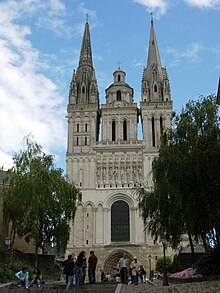Cathédrale Saint-Maurice d'Angers
| The Saint Maurice Cathedral of Angers Cathédrale Saint-Maurice d'Angers |
|
|---|---|

Façade of the Cathedral of Angers
|
|
| Basic information | |
| Location |
Angers, France |
| Affiliation | Roman Catholic |
| Rite | Latin Rite |
| Municipality | Angers |
| Prefecture | Maine-et-Loire |
| Province | Diocese of Angers |
| Region | Anjou |
| Country | France |
| Year consecrated | 1096 |
| Ecclesiastical or organizational status | Cathedral |
| Status | Active |
| Heritage designation | 1862 |
| Leadership | Renaud de Martigné and Ulger |
| Website | http://catholique-angers.cef.fr/Cathedrale-Saint-Maurice-Notre-Dame |
| Architectural description | |
| Architect(s) | Etienne d'Azé, and |
| Architectural type | Church |
| Architectural style | Romanesque, Gothic and |
| General contractor | Normand de Doué and Guillaume de Beaumont |
| Groundbreaking | 1032 |
| Completed | 1523 |
| Specifications | |
| Direction of façade | west |
| Length | 296.82 ft (90.47 m) |
| Width | 75.45 ft (23 m) |
| Width (nave) | 53.74 ft (16.38 m) |
| Height (max) | 252.6 ft (77 m) |
| Spire height | 229.6 and 252.6 ft (70 m and 77 m) |
The Saint Maurice Cathedral of Angers (French: Cathédrale Saint-Maurice d'Angers) is the seat of the Roman Catholic Diocese of Angers in Angers, France.
Built between the 11th and 16th Centuries, It was classified in 1862 as a national monument of France for its mixture of Romanesque and Gothic architectural styles, especially the style, and for the stained glass windows, including the transept's window of Saint Julian, considered to be a masterpiece of French 13th century glasswork.
The original Romanesque church was rebuilt with Gothic details in the mid-12th century. The single-aisle plan was vaulted with pointed arches resting on a re-clad interior elevation. The nave consists of three simple bays, with single bays on either side of a crossing forming transepts, followed by a single-bay choir, backed by an apse.
The Cathedral of Angers was originally dedicated to the Virgin Mary. But, in 396, St. Martin, the Archbishop of Tours, added St. Maurice to the dedication. He had acquired a relic of some of the blood of the members of the Theban Legion, who were martyred, along with their leader St. Maurice, in the 3rd Century for converting to Christianity. The relic was brought to Tours and later, according to legend, a phial of it was given to Angers. In the 7th Century, a devotion to St. Maurilius, the Bishop of Angers in the 4th Century, began. A biography of him was written and, in 873, his body was transferred to the Cathedral. Two hundred years, St. Maurilius and St. Maurice were frequently mentioned together as the patron saints of the Cathedral but eventually St. Maurice became the primary patron of the Cathedral.
...
Wikipedia
